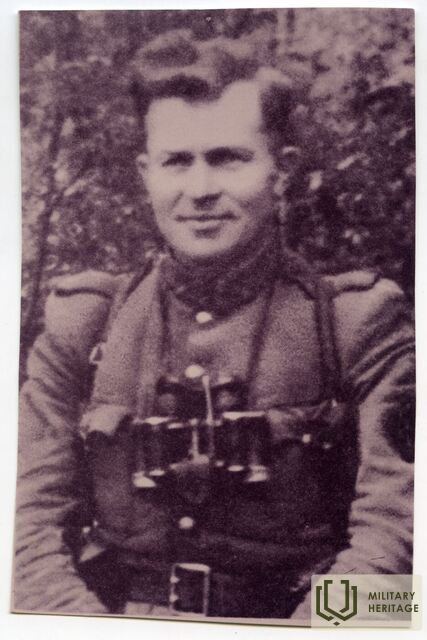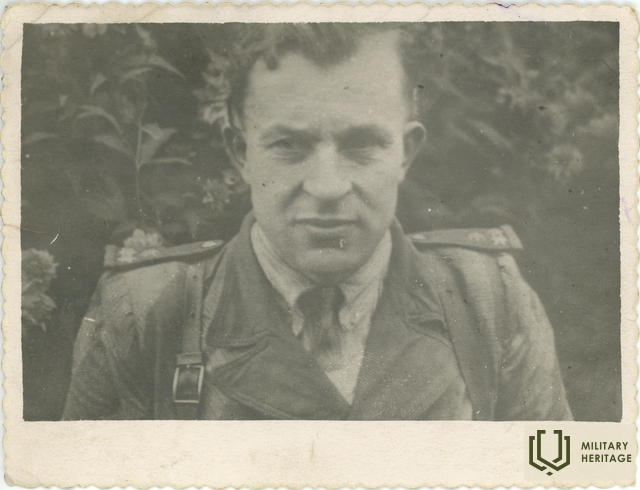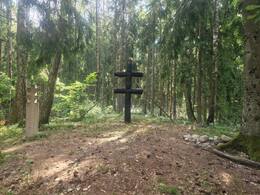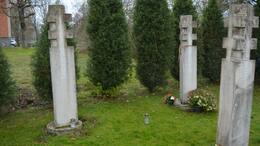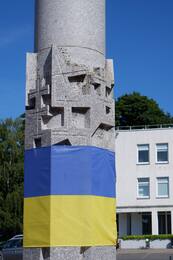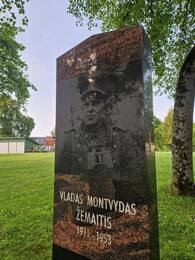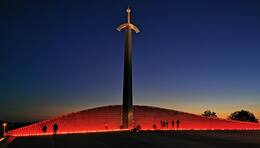Vladas Montvydas-Žemaitis III National Partizans
Vladas Montvydas (nicknames Žemaitis, Etmonas, Algimantas, Dėdė) was born on September 9, 1911 in the village of Gatautiškė, Varniai rural municipality, Telšiai county. His parents were workers at the Gatautiškė manor. After graduating from Požerė primary school, Vladas learned the carpentry trade. While serving in the Lithuanian army, he graduated from the non-commissioned officer school in 1934 and became a foreman. He actively participated in public activities, was a member of the Riflemen's Union and commander of a riflemen's platoon. In 1938, he married Bronislava Ralytė, the seventeen-year-old daughter of a farmer, and became the owner of a 20-hectare farm. Montvydas managed to revive the abandoned farm - he developed the production of bric-a-brac, purchased grain threshing equipment and a horse-drawn grain mill. He installed a wind generator on the roof of the house to generate electricity, and planted a new soda.
As the second Soviet occupation approached, V. Montvydas chose to defend his homeland. At the beginning of 1944, he began organizing the Hawks group of the Lithuanian Freedom Army in the Varniai area. Oaths were taken and weapons were secretly transported in his house. In July 1944, he and his comrade Stasis Beniulis set off for the Plateliai forests to train young people. Montvydas set up the first three partisan hideouts, which led to the Soviet authorities burning down his homestead on Christmas Eve 1944. His wife and five young children were left homeless and were sheltered by relatives and peasants from the villages of Samogitia.
Since August 1945, Montvydas belonged to the Šatrija team, and in 1947 he was appointed its commander. In the winter of 1948, together with the commander of the Samogitian region A. Milaševičius, he reestablished the regional headquarters, became its chief, and from June 1948, the regional commander. He held this position the longest of all Lithuanian partisan regional commanders – 5 years and 3 months. He was a member of the Armed Forces Council of the Lithuanian Freedom Struggle Movement.
V. Montvydas paid much attention to the partisan press. Under his care, the newspapers "Fighting Lithuanian", "Prayer in the Forest" (1951-1952) and "Voice of Freedom" (1945-1953) were published in the Samogitian region. In 1952, a collection of poems "Echoes of the Struggles of Freedom" was published in a circulation of as many as 1,000 copies.
In 1951, Montvydas' wife was arrested and imprisoned in Dzheskazgan, Kazakhstan. On August 23, 1953, betrayed by a resident of the Šilalė district, Vladas Montvydas was killed together with his adjutant B. Alūza-Bedalis in the village of Reistrų by the Sietuva stream, near Lake Lūkstas. After a two-hour shootout with soldiers of the internal troops and the stribes, it is believed that both of them shot themselves. Their bodies were desecrated in the yard of the Varniai stribes headquarters.
After his death, V. Montvydas was awarded high awards: in 1997 - the status of a soldier volunteer, in 1998 - the rank of colonel, in 1999 - the Commander's Cross of the Order of the Cross of Vytis. In 1994, a canister with the archive of V. Montvydas-Žemaitis was found in the Kaltinėnai area, which is now stored in the Special Archives of Lithuania.
More information sources
Related timeline
Related objects
Lithuanian Freedom Army partisan "Vanagi" training and shooting camp in Plokštinė
A Lithuanian Freedom Army (LLA) partisan training and shooting camp, known as the "Vanagai" camp, was established in Samogitia, in the Plokštinė forests, near Plateliai. This camp was an important part of the LLA structure, where partisans prepared for the fight against the Soviet occupation authorities.
The camp was established in August 1944, when the Soviet Union occupied Lithuania for the second time. The members of the "Hawks" group studied here not only shooting and guerrilla warfare tactics, but also survival skills in nature. They were preparing for long-term resistance in the forests in order to be able to operate covertly and organize attacks on Soviet structures as effectively as possible. The camp taught not only armed resistance, but also reconnaissance, communication, camouflage and other skills necessary for partisans.
The forests of Plokštīne were chosen for their density and remoteness – this area allowed the partisans to hide from the occupiers. The camp’s activities eventually covered the surrounding forests with complex partisan trails that were difficult for the Soviets to understand for a long time. Men and women of all ages trained here, including former riflemen, soldiers and ordinary Lithuanian residents, ready to fight for Lithuania’s freedom.
In 2019, the exact location of the "Hawks" military training on August 15–25, 1944, was determined in the Plokštinė forest, which was confirmed by the details of the stories of many presenters - participants of the military training camp, and new, previously unknown data was accumulated about the camp's equipment and the daily life of the "Hawks" who served there. The location was investigated by Gediminas Petrauskas.
Although there are no special signs dedicated to this camp when visiting the site, the past historical events are reflected in the still-found shell casings and bullets and their marks in the pine trees.
Monument to the memory of the partisans of the Samogitian region who died in the Alsėdžiai area
The monument in the Alsėdžiai area is dedicated to honoring the fallen partisans of the Alka and Šatrija detachments of the Samogitian region, who actively fought against the Soviet occupation in the post-war years. The monument commemorates all those who defended Lithuania's freedom and independence in these areas, fighting against much stronger and better armed Soviet forces.
The monument was built to commemorate the fighters of the Alka and Šatrija divisions, who were buried in the trenches at this location between 1944 and 1953.
The monument consists of a composition of typical partisan memorial signs. The authors are designer Romas Navickas and architect Viktorija Molienė. The monument was unveiled on August 29, 2004, thanks to the efforts of Alfons Norkaus-Žilvičis, a former partisan of the Alka detachment of the Samogitian region, and a political prisoner.
Today, this monument is one of many that commemorate the partisan resistance in Samogitia and throughout Lithuania.
Monument "In Memory of the Partisans and Freedom Fights of the Samogitian Region"
The monument standing in Telšiai Independence Square is dedicated to the partisans of the Samogitian region and the Freedom Struggles. Interestingly, impressive monuments have been erected in various Lithuanian cities to commemorate the activities of the partisan districts that operated in that region.
Samogitian Region – a partisan region established in 1945 that united the participants of the Lithuanian resistance in Telšiai, Kretinga, Mažeikiai counties and part of Tauragė county. People of the Lithuanian Freedom Army had been very active in North-Western Lithuania since mid-1944, and the military tradition was very strong here. Fighters who did not belong to the LLA were accepted into the active and organizational sectors.
The district published the newspapers "Voice of Freedom", "Fighting Lithuanian", "Prayer in the Forest". It had three detachments - Karda, Alka and Šatrija. The district headquarters was destroyed on August 29, 1953. The last partisan of the district, Pranas Končius-Adomas, died on July 6, 1965.
The monument consists of a column on a pedestal with a relief composition of crosses in the lower part and inscriptions dedicated to the memory of the partisans. The author is the famous sculptor Regimantas Midvikis, who created many famous sculptures in various Lithuanian cities, including the monument to King Mindaugas in Vilnius.
Monument to Vladis Montvydas-Žemaitis
A monument to one of the partisan leaders, Vladas Montvydas-Žemaitis, has been erected in the town of Varniai, Telšiai district.
The monument was erected to commemorate the 60th anniversary of the death of the partisan commander of the Samogitian region, Vladas Montvydas-Žemaitis. On August 24, 2013, at the initiative of the Lithuanian Freedom Army (LLA) and its chairwoman Irena Montvydaitė-Giedraitienė, a granite monument was erected in memory of the last commander of the Samogitian region, Vladas Montvydas-Žemaitis, with the inscription "Give to the Homeland what you must!"
Vladas Montvydas-Žemaitis belonged to the Riflemen's Union, in 1944. together with others he founded the Telšiai County Hawks Group of the Lithuanian Freedom Army (LLA), which he led, and also established the first 3 partisan hideouts. Under the care of V. Montvydas, the newspapers Kovojantis lietuvis, Malda girije, Laisvės balsas were published in the Samogitian County, and in 1952 the collection of poems Laisvės kovų addai was published.
Vladas Montvydas-Žemaitis was the last and longest-serving partisan commander of the Samogitian region, who died in an ambush in 1953 in the bunker of the Samogitian region headquarters, after about 2 hours of gunfire with soldiers of the internal army and the stribes. His body was desecrated in Varniai near the stribes headquarters, and his burial place is unknown.
Lithuanian Partisan Memorial in Kryžkalnis
The memorial is located in Kryžkalnis, near the intersection of important roads. The large sword-shaped obelisk marking the memorial is clearly visible when driving along the Klaipėda-Vilnius highway near Kryžkalnis.
The Partisan Memorial is dedicated to honoring the Lithuanian partisans who fought against the Soviet occupation in the post-war period for an independent Lithuania. It is one of the largest places in Lithuania that commemorates the sacrifice and memory of the partisans.
The memorial, created by sculptor Tadas Gutauskas and architect Saulius Pamerneckis, was opened on September 20, 2020. It not only commemorates the victims of the past, but also invites visitors to remember the price of freedom and be proud of their country's history.
The memorial consists of three parts: a 25-meter-high sword-shaped obelisk, which symbolizes the strength and fighting spirit of the partisans, as well as a memorial wall, on which are engraved the names of about 20,000 fallen partisans, arranged in steles in the shape of a Vytis cross, and the Square of Honor with the Tomb of the Unknown Partisan, which symbolizes all those who are unknown and unrecorded, but who sacrificed their lives for Lithuania.




